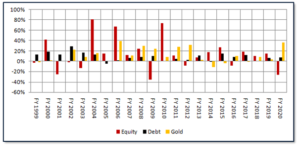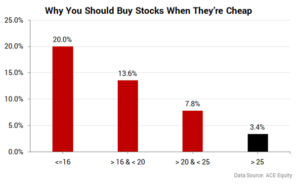Carefully thought out asset allocation is called for while constructing an investment portfolio, in order to meet various goals spread over the lifetime of the investor and also to reduce risk through diversification across asset classes that have low or negative correlation in their price movements. The chart below shows the performance of different asset classes in each financial year from FY 1999 to FY 2020. The proxies used are Nifty 50 for equity and Nifty Benchmark 10 year G-Sec index for fixed income assets.

Source: National Stock Exchange
But then, there is a saying that the king can do no wrong! There are investment wizards who seem to defy the above logic every once in a while and make a killing through “concentrated” investment.
In 1987 when the markets in the US crashed, the stock of the well known company Coca Cola witnessed a sharp fall. Warren Buffet, the legendary Oracle of Omaha, descended on the market and loaded up the stock and in style. By early 1988 he had invested nearly US$ 1 billion in the stock of Coke, snapping up 6.2% of the company’s shares, making it the largest holding in his portfolio. By June 2019, his (Berkshire Hathaway’s) holding in Coca Cola was worth about US$ 19 billion. Well, Buffet was not alone in spotting the opportunity in Coke. As early as 1920, a shrewd banker named Paul Munroe saw in Coca Cola a highly credible growth story.
Coca-Cola went public at US$ 40 per share in 1919. But a conflict with the sugar industry resulted in a 50% crash in the share price shortly thereafter, when it reached US$ 19 per share. Given that the company’s profits, return ratios and cash flows were still attractive, the stock was trading incredibly cheaply. The banker, Mr. Munroe encouraged his depositors in the town of Quincy, Florida to buy the stock of Coca Cola – putting some 67 investors on the path to becoming ‘one stock millionaires‘. Thanks to this move, the town of Quincy became the single richest town per capita in the entire United States, and several of its inhabitants were dubbed ‘Coca Cola Millionaires.’
Buffet is also of the opinion that diversification should not result in spreading one’s resources too thin across investments. As he says, “No one has ever gotten rich on the 7th best idea”. Markets being efficient, big opportunities to make money are few and far between. Hence when a big opportunity is spotted, one has to put out the bucket and not the tumbler. So in 2017 after diligently analysng its performance, he decided to buy substantial stake in the tech giant Apple. Current value of this investment, when compared to its cost of acquisition, has appreciated 3 times to around US$ 104 billion, which in rupee terms is in excess of Rs 7 lac crores! No wonder, Buffet’s Apple investment is being dubbed the greatest trade ever.
But is there method which guides him when he takes such concentrated bets? His bets appear eerily similar to a formula invented by a mathematician John Kelly. The formula is about how much money to allocate to a single bet or a stock where you expect the returns to be positive.
The application of the formula, without going into its mathematical details, broadly works as follows.
Imagine there’s a stock that has an equal chance of going up 3 times if the underlying assumptions hold out and of falling 50% if they don’t. Then as per the Kelly’s formula, you should put as much as 37.5% of your total corpus into this one stock. Alternatively, if the stock has an equal chance of going up 2 times and falling 50% then the maximum allowable allocation comes down to 25%. Thus, bigger the upside and greater the probability of achieving it, the higher the allocation.
But there’s one caveat.
Investing is an exercise in uncertainty. You can only work on the basis of probabilities of your assumptions coming true. Therefore, the upper limit per stock can be restricted to maybe 25%-30%. This should be the case even if the formula recommends a much higher allocation. Thus, experts opine that Warren Buffett’s massive positions over the years have the Kelly formula written all over them.
But Kelly’s formula has applications that go beyond individual stock allocations. You could use it to decide allocation between stocks and bonds as well.
The long term average of the Sensex PE (price to earnings ratio) is around 19-20. Thus, when the Sensex falls significantly below this level, one should maximise exposure to stocks and when the Sensex multiple goes well past 20x, it is time to move out of stocks and increase allocation to bonds. In the chart below the vertical axis denotes Sensex returns and the horizontal axis the PE (Price to Earnings multiples).

Whenever the Sensex PE has gone below 20x, the forward 3-year returns have been in mid to high double digits on an average. And when the Sensex has gone past the 25 PE mark, the forward returns have fallen to a measly 3.4%. This is lower than even what fixed deposits offer.
Guess what the Sensex PE was when the markets hit bottom in March of this year after falling nearly 40% from its peak? Well, it had come down to 15-16; a valuation level that based on history and the Kelly formula, called for maximum allocation to stocks. But markets have seen a liquidity driven rally since then and as of August 28th the Sensex PE was more than 28. This calls for reducing exposure to stocks and increasing exposure to bonds. Thus, if you put some money back in March/April 2020 and are sitting on strong gains, it may not be a bad idea to book partial profits and take some money off the table.

